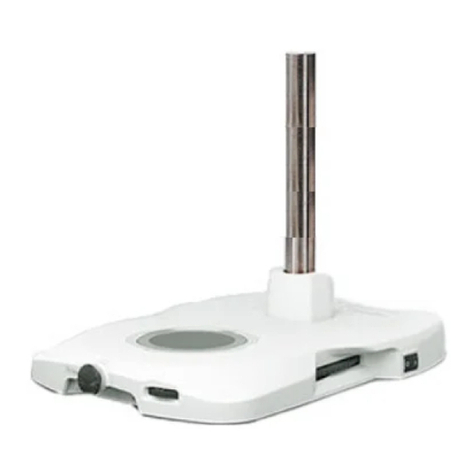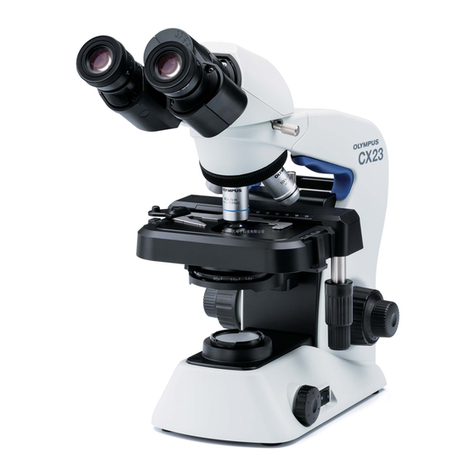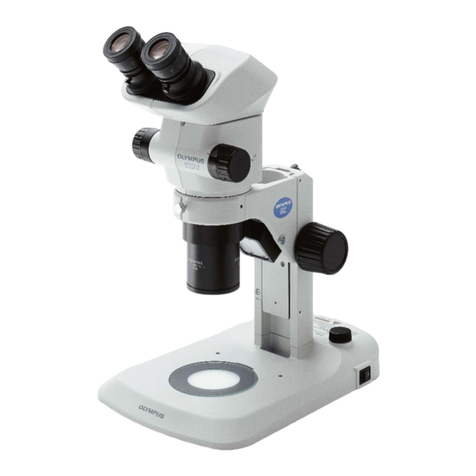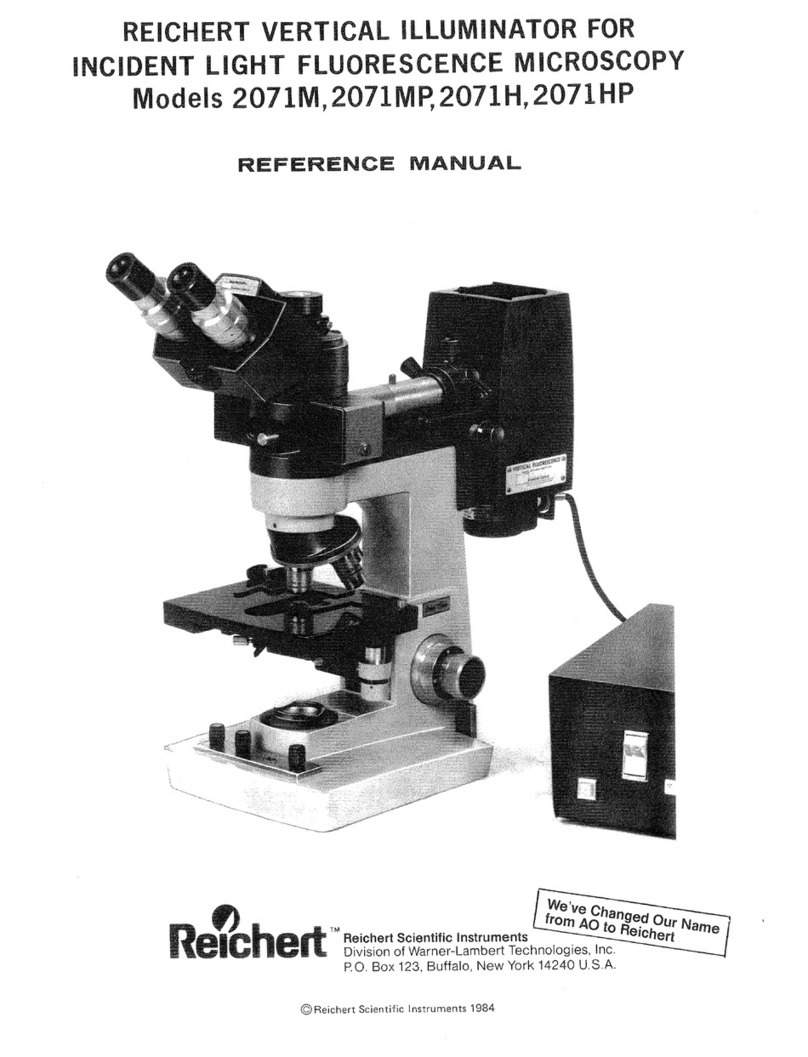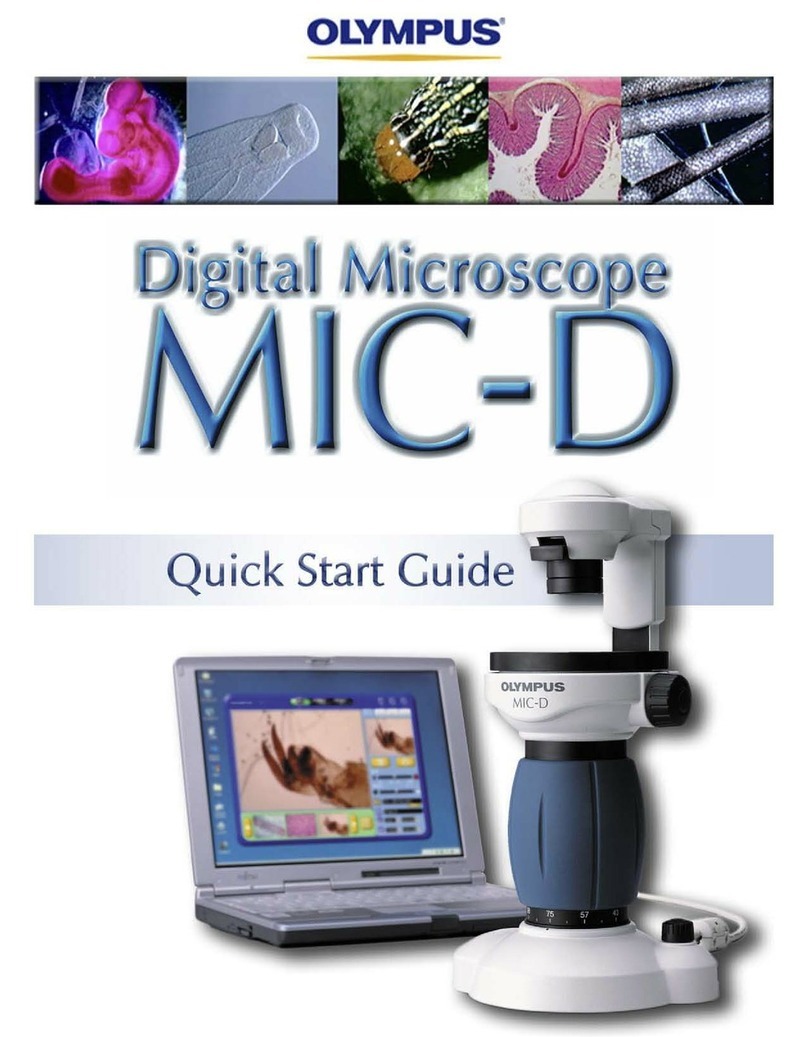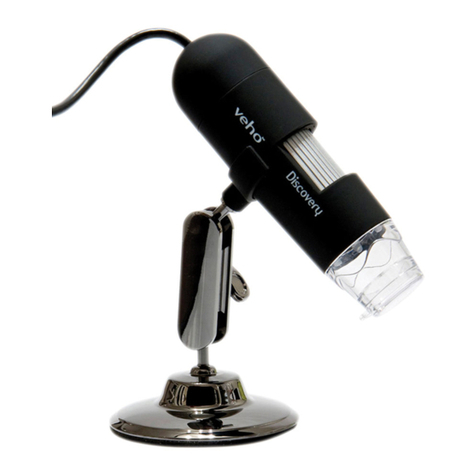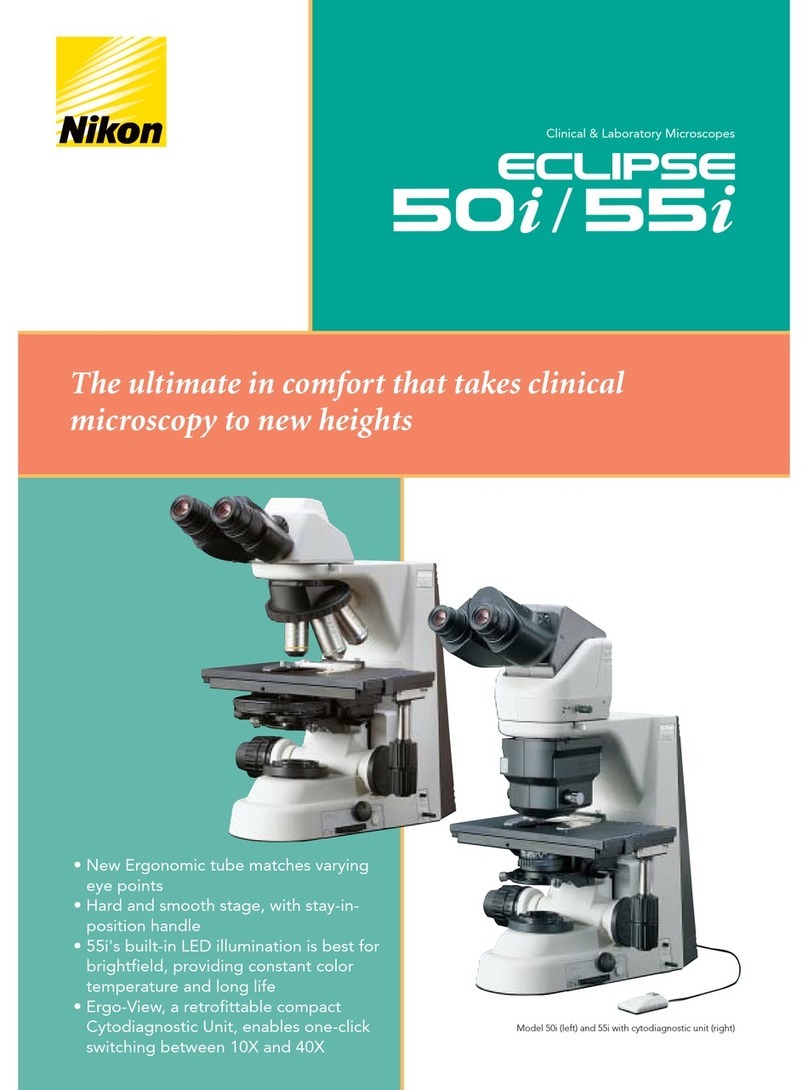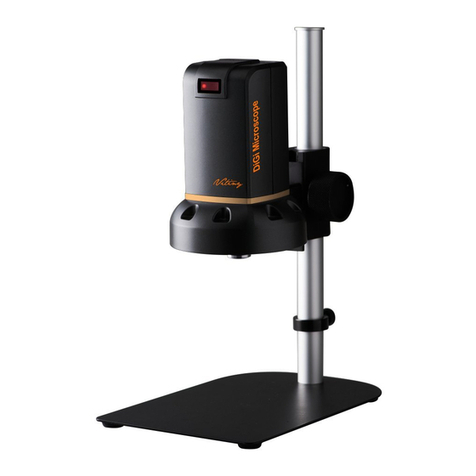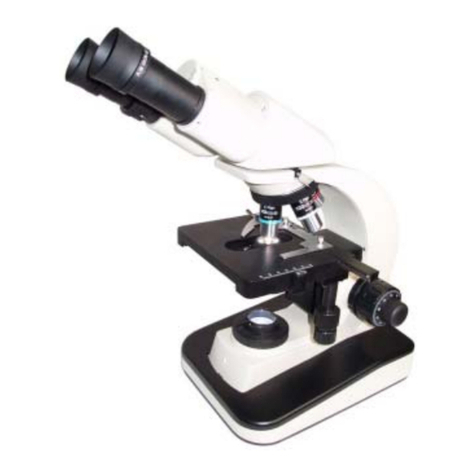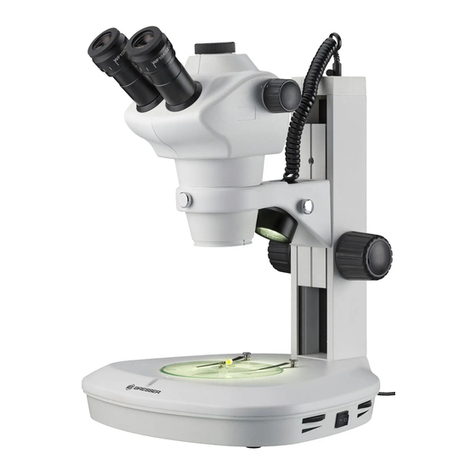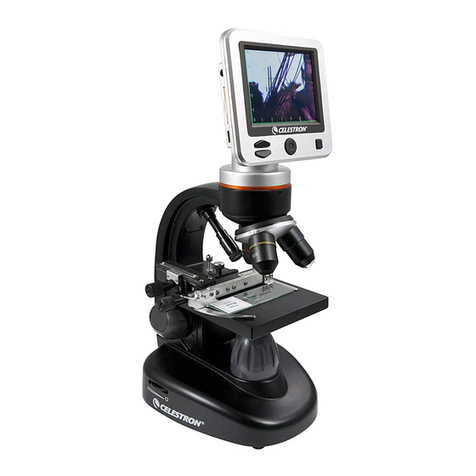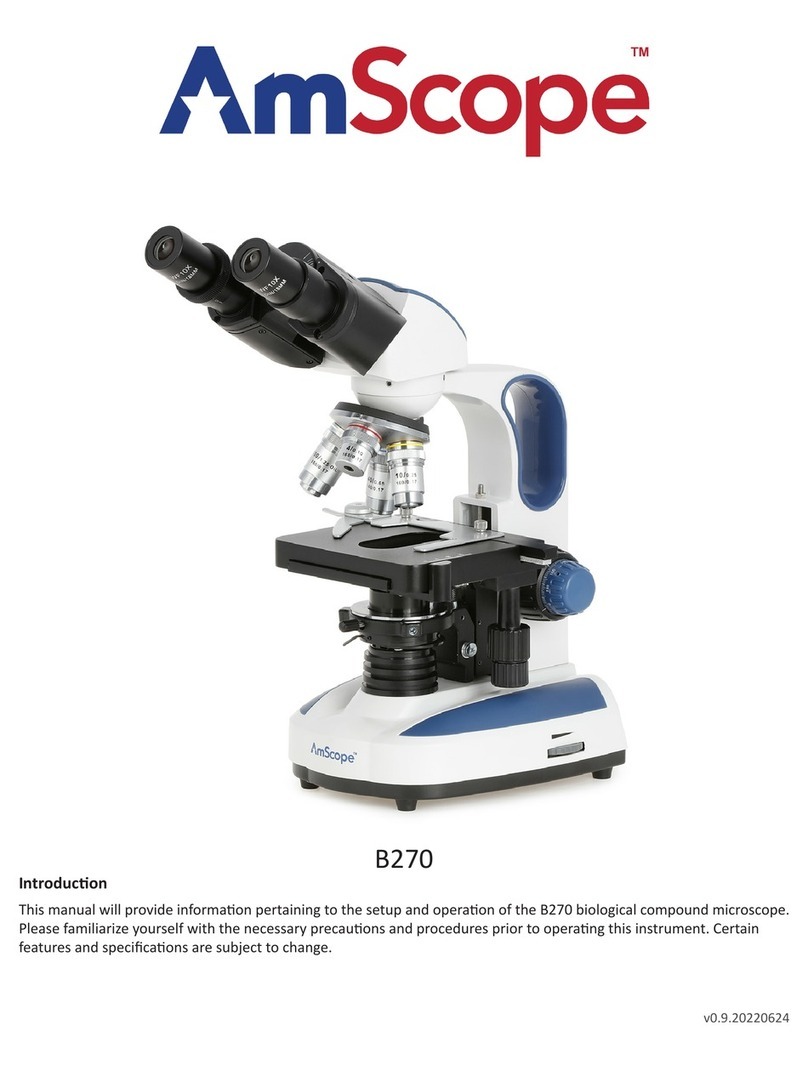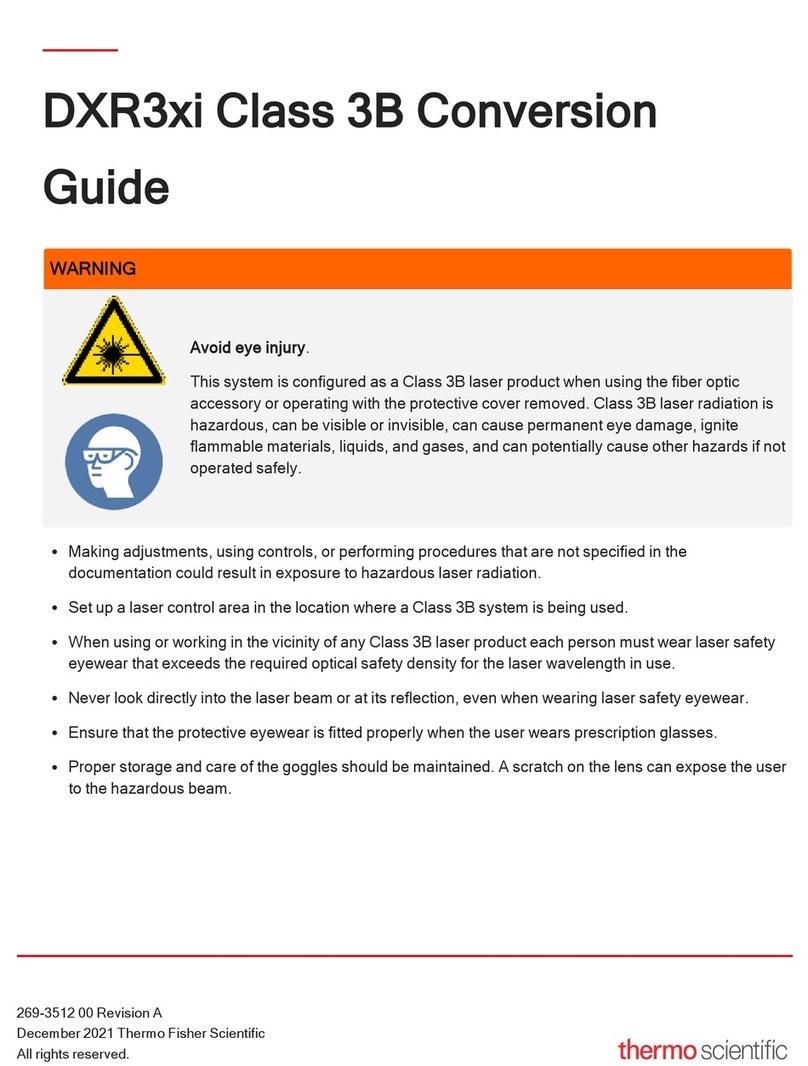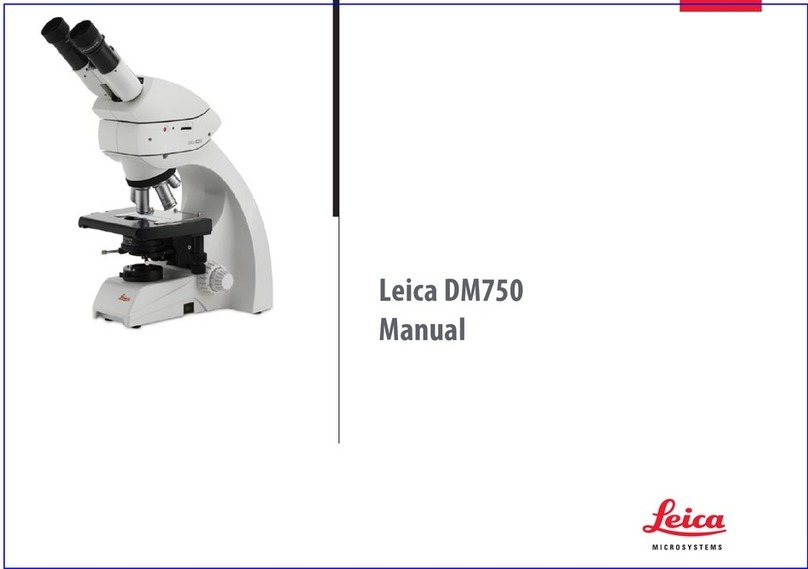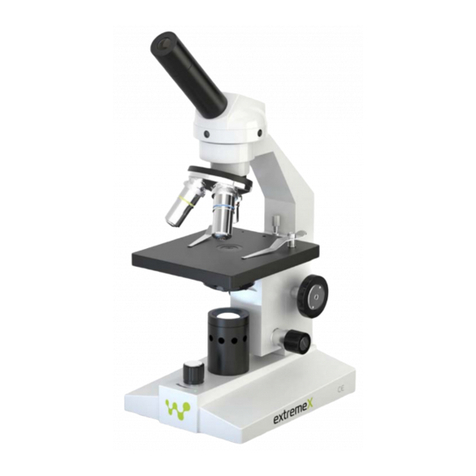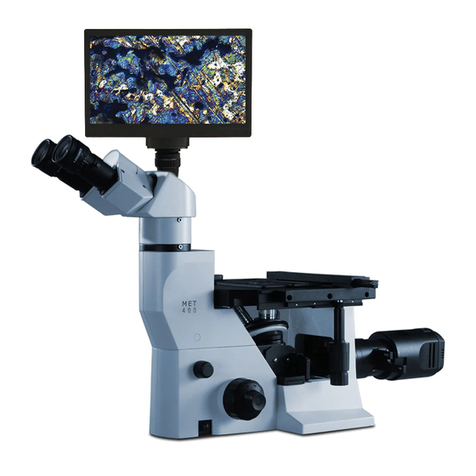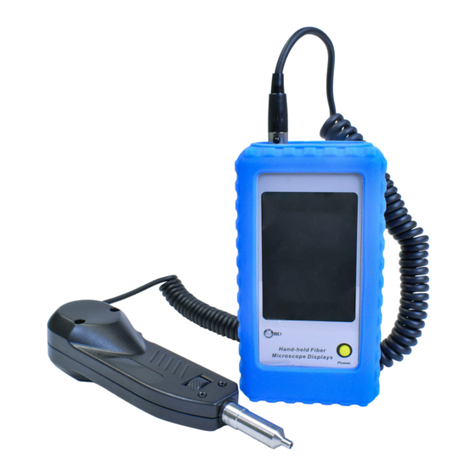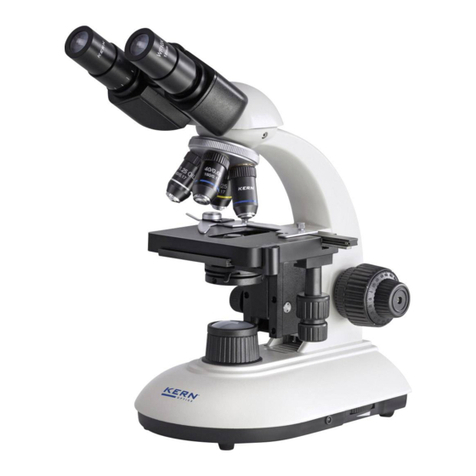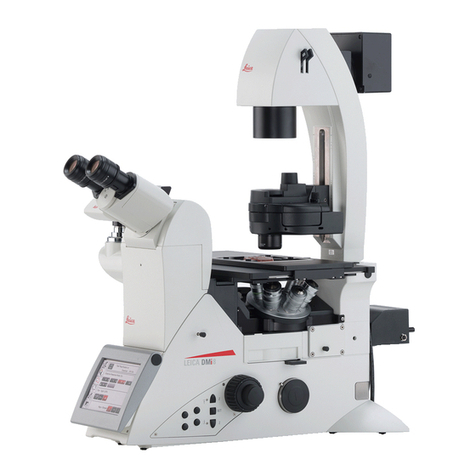Evident SZ61 User manual

INSTRUCTIONS
This instruction manual is for the Olympus Zoom Stereo Microscopes. To ensure the safety,
obtain optimum performance and to familiarize yourself fully with the use of this microscope, we
recommend that you study this manual thoroughly before operating the microscope.
Retain this instruction manual in an easily accessible place near the work desk for future reference.
For details of products included in the configuration of this system, see “1 MODULES AND
NOMENCLATURE” (P.3) and “8 OPTIONAL MODULES” (P. 18).
ZOOM STEREO MICROSCOPES
SZ61/SZ61-60
SZ61TR
SZ51/SZ51-60
Optical Microscope and Accessory


SZ2 series
IMPORTANT....................................................................................................................................................... 1
1 MODULES AND NOMENCLATURE .......................................................................................... 3
2 SUMMARY OF OBSERVATION PROCEDURE.................................................................. 5
2-1 Preparation.............................................................................................................................................................. 5
2-2 Observation Procedure................................................................................................................................ 5
3 OPERATION.................................................................................................................................................. 6
3-1 Base.............................................................................................................................................................................. 6
1Using the Stage Plate................................................................................................................................................................6
2Adjusting the Focus Adjustment Knob Tension...............................................................................................................................6
3-2 Microscope Body.............................................................................................................................................. 6
1Adjusting the Interpupillary Distance...........................................................................................................................6
2Adjusting the Diopter (Zoom Confocality Adjustment)................................................................................7
3Using the High/Low Zoom Magnification Stopper .........................................................................................8
4Using the Eye Shades ..............................................................................................................................................................8
5Mounting the Eyepiece Micrometer Disk.................................................................................................................9
6Using the Auxiliary Objectives........................................................................................................................................10
7Selecting the Light Path (SZ61TR) ..............................................................................................................................10
8Adjusting the Confocality of the Camera (SZ61TR)..................................................................................... 11
4 TROUBLESHOOTING GUIDE ......................................................................................................12
5 SPECIFICATIONS ...................................................................................................................................13
6 OPTICAL PERFORMANCE.............................................................................................................14
7 ASSEMBLY...................................................................................................................................................15
7-1 Assembly Diagram .........................................................................................................................................15
7-2 Detailed Assembly Procedures...........................................................................................................16
8 OPTIONAL MODULES .......................................................................................................................18
8-1 BX Stage Adapter Type 1 SZX-STAD1 ..........................................................................................18
8-2 Stage Adapter Type 1 SZH-STAD1..................................................................................................20
8-3 Gliding Stage SZH-SG................................................................................................................................. 21
8-4 Cup Stage SZH-SC.......................................................................................................................................22
CONTENTS


1
SZ2 series
IMPORTANT
1. After the equipment has been used in an observation of a
specimen that is accompanied with a potential of infection, clean
the parts coming in contact with the specimen to prevent infection.
· Moving this microscope is accompanied with the risk of
dropping the specimen. Be sure to remove the specimen
before moving this product.
The SZ2 series of stereo microscopes are provided with ESD (Electro-Static Discharge) protection specifications. They are
provided with electroconductive coating in their external finish to reduce the surface resistance and grounding lead wires
in their standard base or frame to eliminate static electricity from them.
To maintain the ESD protection performance, always use the microscope in combination with the
modules described in this manual or options having the ESD protection specifications. Otherwise, the
grounding will not work properly.
·The eye shades of the eyepieces are not provided with the ESD protection performance. Be sure to
remove them
·The SZ2-SPBW stage plate is provided with the ESD protection performance only in the black surface.
NOTE
SAFETY PRECAUTIONS
b
a
· Hold the bottom of the stand with one hand while holding base column with the other hand to avoid tilting the
microscope.
· In case the specimen is damaged by erroneous operation, promptly take the infection prevention measures.
2. When the optional 0.5X auxiliary objective ais used, the microscope become unstable due to the use of the SZ2-
ET auxiliary sleeve b. Be careful not to topple down the microscope. )
In addition, when a camera is mounted on the SZ61TR, special care is required because the microscope becomes
more unstable.
1Getting Ready
1. A microscope is a precision instrument. Handle it with care and avoid subjecting it to sudden or severe impact.
2. Do not use the microscope where it is subjected to direct sunlight, high temperature and humidity, dust or
vibrations. (For the operating conditions, see “SPECIFICATIONS” on page 13.)
3. Be careful not to leave stains and fingerprints on the lens surfaces.
Contamination of the lens and mirror deteriorates the view of images.
4. Do not turn the left and right zoom adjustment knobs in the opposite directions, as this will result in a failure.
5. The rubber parts of the eyepiece sleeves are fragile and should be handled carefully. If they are damaged, dirt will
penetrate inside the microscope.

2
2Maintenance and Storage
1. To clean the lenses and other glass components, simply blow dirty away using a commercially available blower
and wipe gently using a piece of cleaning paper (or clean gauze).
If a lens is stained with fingerprints or oil smudges, wipe it gauze slightly moistened with commercially available
absolute alcohol.
Since the absolute alcohol is highly flammable, it must be handled carefully.
Be sure to keep it away from open flames or potential sources of electrical sparks –– for
example, electrical equipment that is being switched on or off.
Also remember to always use it only in a well-ventilated room.
2. Do not attempt to use organic solvents to clean the microscope components other than the glass components. To
clean them, use a lint-free, soft cloth slightly moistened with a diluted neutral detergent.
3. Do not disassemble any part of the microscope as this could result in malfunction or reduced performance.
4. When disposing of the microscope. Check the regulations and rules of your local government and be sure to
observe them.
CAUTION
If the microscope is used in a manner not specified by this manual, the safety of the user may be imperiled. In addition,
the equipment may also be damaged. Always use the equipment as outlined in this instruction manual.
The following symbols are used to set off text in this instruction manual.
CAUTION : Indicates that failure to follow the instructions in the warning could result in
bodily harm to the user and/or damage to equipment (including objects in the
vicinity of the equipment).
NOTE
: Indicates that failure to follow the instructions could result in damage to equipment.
TIP
: Indicates commentary (for ease of operation and maintenance).
3Caution
4Intended use
This product has been designed to be used to observe magnified images of specimens in various routine work and
research applications.
This includes the observation of living cells or of specimen taken from tissues to gain physiological or morphological
information at hospitals or laboratories.
Typical field of applications are genetics, human blood and tissue examination, neurology, pharmacology and cellular biology.
Further applications of this device include measurement and imaging for materials research, precision manufacturing, electronics
design and medical device fabrication. Additional industrial applications are added by individual companies and researchers.
Do not use this product for any purpose other than its intended use.
This product complies with the requirements of directive 98/79/EC concerning in vitro diagnostic medical
devices. CE marking means the conformity to the directive.
This product is applied with the requirements of EMC standard IEC/EN61326-2-6 and IEC/EN61326-1
concerning electromagnetic compatibility.
This product complies with the emission and immunity requirements described in IEC61326 series. The
electromagnetic environment should be evaluated prior to operation of this product.

3
SZ2 series
1 MODULES AND NOMENCLATURE
Eyepiece clamping knob
(x 2)
Accessory mount thread
(x 5)
Zoom adjustment knob (Page 7and 8)
· SZ61/61-60/TR: 0.67X to 4.5X
· SZ51/51-60: 0.8X to 4X
Focus adjustment knob
(Page 6)
Stroke : 120 mm
Eye shade (Page 8)
Auxiliary objective mount thread
Optional auxiliary objectives
· 110ALK0.3X
· 110ALK0.4X
· 110AL0.5X-2
· 110AL0.62X
· 110AL0.75X-2
· 110AL1.5X
· 110AL2X-2
Optional stage mounting holes
M4 screw (x 2)
Accessory mount holes
Eyepiece
· WHSZ10X
· WHSZ10X-H
· WHSZ15X-H
· WHSZ20X
· WHSZ20X-H
· WHSZ30X-H
Body clamping knob
(Threaded for accessory mounting)
Microscope Body
· SZ61
· SZ61-60
· SZ61TR
· SZ51
· SZ51-60
Stage Plate
· SZ2-SPBW
(ESD protection on black surface)
· SP-C
Olympus classifies SZ61, SZ61-60, SZ61TR, SZ51 and SZ51-60 as an optical microscope and other units as optical
microscope accessories.
Stand
Standard stand: SZ2-ST
LED illuminator stand: SZ2-ILST*
LED transmitted light illumination:
SZX2-ILLTQ*
SZX2-ILLTS*
A separate instruction manual is available for the module marked *.

4
Observation Tube of SZ61TR
C-mount (Page 11)
C-mount clamping screw
Confocality adjustment clamping
screw (Page 11)
(x 2)
Light path selector lever (Page 10)
Pulled out : Camera path 100%
(Right eyepiece sleeve
light path 0%)
Pushed in : Right eyepiece sleeve
light path 100%

5
SZ2 series
2SUMMARY OF OBSERVATION PROCEDURE
Ref. Page
1. Confirm the mounting, particularly that of the microscope body. .......................................................................................................................................(Page 15 — 17)
2. Confirm that the eyepieces are positioned correctly with respect to the standard base...................................................................................(Page 16)
3. Adjust the rotation tension of the focus adjustment knob............................................................................................................................................................................(Page 6)
4. Prepare the light source as required.
2-2 Observation Procedure
2-1 Preparation
Place the specimen on the stage plate. (Page 6)
Adjust the interpupillary distance. (Page 6)
1
2
Adjust the eyepiece diopter. (Page 7)
This operation is not possible with the eyepieces without
helicoids (WHSZ10X/20X).
The operation is slightly difference when a micrometer is mounted in
one of the eyepieces with helicoids.
3
NOTE
Set the zoom adjustment knob afor the lowest magnification and
rotate the focus adjustment knob bto bring the specimen into
approximate focus.
Rotate the zoom adjustment knob ato the target magnification
and rotate the focus adjustment knob bto bring the specimen into
accurate focus.
4
5
ab

6
3 OPERATION
3-1 Base
When reflected light illumination is used, the stage plate can be placed
either the white or black surface facing up depending on which side
makes the specimen easier to view.
·To maintain the ESD performance, use the black surface of
the SZ2-SPBW stage plate.
·When transmitted light illumination is used, use the optional
SP-C transparent glass stage plate.
NOTE
This operation is intended to facilitate the rotation of the
knobs while preventing spontaneous drop of the microscope
body. It is recommended to set the knob tension to a slightly
higher level than the point where spontaneous drop occurs.
Hold the left and right focus adjustment knobs awith both hands,
fix the left knob and rotate the right knob. The rotation tension of the
knobs increases or decreases according to the direction in which the
right knob is rotated.
TIP
1
1Using the Stage Plate
2Adjusting the Focus Adjustment Knob Tension
a
Clamp.
To increase
To decrease
3-2 Microscope Body
While holding the left and right eyepiece sleeves awith both hands,
look through the eyepieces and adjust for binocular vision until the
left and right fields of view coincide completely.
1Adjusting the Interpupillary Distance
a

7
SZ2 series
The adjustment operation is variable whether the eyepieces
use an eyepiece micrometer disks or not.
Eyepieces without eyepiece micrometer disk
Turn the diopter adjustment rings bof the left and right eyepieces
to positions “0”.
Place an easy-to-observe specimen on the stage plate.
Set the zoom adjustment knob cfor the lowest magnification and
rotate the focus adjustment knob dto bring the specimen into focus.
Set the zoom adjustment knob cfor the highest magnification and
rotate the focus adjustment knob dto bring the specimen into focus.
Set the zoom adjustment knob cfor the lowest magnification and
rotate the diopter adjustment rings bof the left and right eyepieces,
instead of the focus adjustment knob, to bring the specimen into focus.
Eyepieces with eyepiece micrometer disk
Look through the eyepiece with eyepiece micrometer disk and rotate its
diopter adjustment rings bto bring the micrometer scale into focus.
Place an easy-to-observe specimen on the stage plate.
Set the zoom adjustment knob cfor low magnification, look through
the eyepiece with eyepiece micrometer disk and rotate the focus
adjustment knob dto bring the specimen into focus.
Set the zoom adjustment knob cfor the highest magnification and
rotate the focus adjustment knob dto bring the specimen into focus.
Set the zoom adjustment knob cfor the lowest magnification and
rotate the diopter adjustment ring eof the eyepiece without eyepiece
micrometer disk, instead of the focus adjustment knob d, to bring
the specimen into focus.
Note the left and right diopter scale values so that it can be
quickly duplicated in future observations.
Diopter scale of the 10X eyepieces
The valid range of the diopter scale is between –8 and +5 but
a slight margin is added to it. Therefore, the diopter value may
exceed +5 or –8 when it is adjusted to the maximum. In this
case, whether the diopter value is over +8 or under –5 can be
identified by the length of the eyepiece.
TIP
1
2
3
4
5
1
2
3
4
5
TIP
TIP
b
c
d
c
d
b
e
2Adjusting the Diopter
(Zoom Confocality Adjustment)
2
-8 +5

8
The eye shades are not provided with ESD protection
performance.
When ESD protection is required, do not use the eye
shades.
When Wearing Eyeglasses
Use with the eye shades in the normal, folded-down position. This will
prevent the eyeglasses from being scratched.
When Not Wearing Eyeglasses
Extend the folded eye shades in the direction of the arrow to prevent
extraneous light from entering between the eyepieces and eyes.
NOTE
4Using the Eye Shades
The magnification can be limited in the desired range by
setting each stopper on the microscope body (also used as
the magnification indices) and the stopper ring on each zoom
adjustment knob. The right zoom adjustment knob is used to
limit the higher end of the magnification, and the left knob is
used to limit the lower end.
Using an Allen wrench, loosen the clamping screw of the right stopper
ring aand free it. (Also free the left knob in this way.)
Rotate the right zoom adjustment knob bto align the desired higher-
limit magnification with the index (stopper) c.
Gently apply the stopper ring ato the stopper cand tighten the
clamping screw using the Allen wrench to retain this condition.
Set the left zoom adjustment knob according to the desired lower-limit
magnification by rotating the left knob and clamping the left stopper
ring in the same way as above.
TIP
1
2
3
4
b
c
a
3Using the High/Low Zoom Magnification
Stopper
3

9
SZ2 series
WHSZ10X-H/15X-H/20X-H
Rotate the disk-mounting ring aof the eyepiece counterclockwise
to remove.
Prepare an eyepiece micrometer disk b(24 mm dia. x 1.5 mm thick),
remove dust and dirt from its surface, and fit it into the disk-mounting
ring aso that the engraving on the micrometer disk faces downward.
Gently screw in the disk-mounting ring aincorporating the eyepiece
micrometer disk into the eyepiece. Turn the ring clockwise to attach
it firmly.
WHSZ30X-H
Rotate the disk-mounting ring cof the eyepiece counterclockwise
to remove.
Rotate the push ring dof the eyepiece micrometer disk
counterclockwise to remove.
Prepare an eyepiece micrometer disk e(24 mm dia. x 1.5 mm thick),
remove dust and dirt from its surface, place it on the disk-mounting ring
cwith the engraving facing downward, and fix it with the push ring d.
Gently screw in the disk-mounting ring cincorporating the eyepiece
micrometer disk into the eyepiece. Turn the ring clockwise to attach
it firmly.
·Themicrometerdiskframemaybetightforcertainmicrometerdisks.
In this case, turn the frame by holding the circumference with
a light, uniform force or by applying the frame against a rubber
sheet. Do not grasp the frame with a strong force, as this may
deform the frame and make it harder to remove it.
· Be careful not to touch the lens surface with your finger.
Due to their structures the WHSZ20X-H/30X-H eyepieces
apply a magnification on the focused plane of the
eyepiece micrometer disk.
These magnifications are 1.3X with the WHSZ20X-H and
2X with the WHSZ30X-H. Be sure to compensate for these
magnifications when using the eyepiece micrometer disk
in measurements.
Also, insertion of the eyepiece micrometer disk extends
the light path length and deviates the position of the
diopter scale. Correct this deviation by turning the diopter
adjustment ring of the eyepiece toward “+”.
When the eyepiece micrometer disk is not used, store it by
wrapping in a clean, soft cloth.
1
2
3
1
2
3
4
TIP
NOTE
TIP
5Mounting the Eyepiece Micrometer Disk
a
d
e
b
c
Indication
engraved surface
Indication
engraved surface
1
3
2
1
4
5
2
3

10
Always move the light path selector lever auntil it hits
the stop position.
For observation through the binocular light path, push in the light
path selector lever atill the stop position.
In this position, the whole light (100%) goes to the binocular tube.
For the camera light path, pull out the light path selector lever atill
the stop position.
In this position, a mirror is inserted into the light path so the whole
light for the right eyepiece sleeve (100%) is sent to the camera light
path.
NOTE
1
2
7Selecting the Light Path (SZ61TR)
a
All of the auxiliary objectives are provided with the ESD
protection performance.
·The 0.3X and 0.4X auxiliary objectives cannot be used in
combination with the standard base because their working
distances are too long.
·The 0.5X auxiliary objective (110AL0.5X-2) also has a long
working distance, but this can be combined with the
standard base provided that the auxiliary sleeve (SZ2-ET)
is used. In this case, however, the microscope becomes
unstable and needs care against toppling it down.
·Screw the auxiliary objective firmly into the auxiliary objective mount
thread at the bottom of the microscope body.
TIP
NOTE
6Using the Auxiliary Objectives
Auxiliary sleeve
SZ2-ET
Microscope body
Standard
base

11
SZ2 series
Ensuring the confocality between the observation image and
the camera monitor image makes it possible to maintain
accurate focusing of the observation image or monitor image
even when the light path is switched.
Adjust the diopter of the eyepiece (see page 7) and bring the
specimen into focus.
Pull out the light path selector lever aand set the magnification to
the minimum.
Slightly loosen the two confocality adjustment clamping screws b
and C-mount clamping screw c.
Hold the camera dand rotate the confocality eto focus on the
monitor image.
After the adjustment, tighten the clamping screws band c.
Applicable cameras (image pickup device size) and field numbers
The camera light path incorporates a 0.5X lens.
TIP
1
2
3
4
TIP
a
b
c
d
e
2/3 in. image pickup device
(Diagonal length 22 mm)
1/2 in. image pickup device
(Diagonal length 16 mm)
FN 22
(With 10X eyepiece)
2/3 in. image pickup device
(Diagonal length 22 mm)
1/2 in. image pickup device
Rotation of monitor image
The monitor image is rotated slightly because the right observation
light path, which is tilted slightly, is used as the camera light path.
The monitor image can be aligned with the observation image by
rotating the camera.
8Adjusting the Confocality of the Camera (SZ61TR)

12
Problem Cause Remedy Page
1. The left and right fields of view
do not coincide.
Interpupillary distance is adjusted
improperly.
Adjust it correctly. 6
The parallax is not corrected. Adjust it correctly. 7
The magnifications of the left and
right eyepieces are different.
Use the eyepieces with the same
magnification for the left and right
by replacing one of them.
3
2. Dirt or dust is visible in the field
of view.
Dirt/dust on specimen. Clean thoroughly.
2
Dirt/dust on eyepieces
3. Visibility of observed image is
poor.
Dirt/dust on the dustproof glass on
the tip of the objective.
Clean thoroughly. 2
4. Zooming causes defocusing of
the observed image.
The eyepiece diopter is adjusted
improperly.
Adjust it correctly. 7
The focus adjustment is inaccurate. Adjust the focus accurately. 5
5. The focus adjustment knob does
not rotate smoothly.
The rotation tension of the knob is
set too high.
Decrease the rotation tension to an
optimum level. 6
6. The microscope body drops
spontaneously, causing the
focusing to be deviated during
observation.
The rotation tension of the knob is
set too low.
Increase the rotation tension to an
optimum level. 6
7. The right field of view or the
monitor image is cut off.
The light path selector lever is not
set properly to a stop position.
Push in or pull out the lever all the
way till the stop position. 10
8. Zooming causes important
defocusing of the monitor image.
The confocality of the camera is
adjusted improperly.
Adjust it properly. 11
4TROUBLESHOOTING GUIDE
Under certain conditions, performance of the microscope may be adversely affected by factors other than defects. If
problems occur, please review the following list and take remedial action as needed. If you cannot solve the problem
after checking the entire list, please contact Olympus.

13
SZ2 series
5SPECIFICATIONS
Item SZ61 SZ61-60 SZ61TR SZ51 SZ51-60
Microscope
body
Magnification 0.67X to 4.5X 0.8X to 4X
Zoom ratio 6.7 5
Working distance 110 mm
Tube tilting angle 45° 60° 45° 60°
Interpupillary
distance
adjustment
Left/right interlocked.
Adjustment range: 52 to 76 mm (using the WHSZ10X eyepieces)
Camera
compatibility
C-mount
(0.5X lens built in)
Zoom adjustment
knobs
Left/right single-shaft horizontal knobs
(with high/low zoom magnification stopper)
Auxiliary objective Mounting by screwing into the thread at the bottom of frame (M48 thread x 0.75)
Eyepieces**
WHSZ10X-H : FN 22, 24 mm eyepiece micrometer disk mountable
WHSZ15X-H : FN 16, 24 mm eyepiece micrometer disk mountable*
WHSZ20X-H : FN 12.5, 24 mm eyepiece micrometer disk mountable*
WHSZ30X-H : FN 7, 24 mm eyepiece micrometer disk mountable*
Standard stand
SZ2-ST
Frame installation Mounting diameter 76 mm
Focus adjustment
Rack-and-pinion using ball guide
Knob rotation tension adjustable
Focusing stroke 120 mm
Stage plate Diameter 100 mm, milky white (back side black)
Light source
installation Light guide illumination system (SZ2-CLS) mountable.
Operating environment
· Indoor use
· Altitude : Max. 2000 m
· Ambient temperature : 5° to 40°C (41° to 104°F)
· Maximum relative humidity: 80% for temperatures up to 31°C (88°F),
decreasing linearly through 70% at 34°C (93°F), 60% at 37°C (99°F), to 50%
relative humidity at 40°C (104°F)
· Supply voltage fluctuations : ±10%
· Pollution degree : 2 (in accordance with IEC60664)
· Installation (overvoltage) category : II (in accordance with IEC60664)
* The micrometer and squared scale outside the field number are invisible.
** The WHSZ10X and WHSZ20X eyepieces without helicoids are also available. (An eyepiece micrometer cannot be
mounted.)

14
6OPTICAL PERFORMANCE
Zoom
Magnification
Working
Distance
(mm)
Eyepieces
WHSZ 10X
FN 22
WHSZ 15X
FN 16
WHSZ 20X
FN 12.5
WHSZ 30X
FN 7
Total
Power
Actual Field
(mm)
Total
Power
Actual Field
(mm)
Total
Power
Actual Field
(mm)
Total
Power
Actual Field
(mm)
0.67X
110
6.7X 32.8 10X 23.8 13.4X 18.7 20X 10.4
0.8X 8X 27.5 12X 20 16X 15.6 24X 8.8
1X 10X 22 15X 16 20X 12.5 30X 7
2X 20X 11 30X 8 40X 6.3 60X 3.5
4X 40X 5.5 60X 4 80X 3.1 120X 1.8
4.5X 45X 4.89 67.5X 3.6 90X 2.8 135X 1.6
Auxiliary objectives (optional)
Auxiliary Objective Working Distance (mm) Auxiliary Objective Working Distance (mm)
110ALK0.3X 350 — 250 110AL0.75X-2 130
110ALK0.4X 250 — 180 110AL1.5X 61
110AL0.5X-2 200 110AL2X-2 38
110AL0.62X 160
·The working distances of the 110ALK0.3X and 0.4X can be varied according to the system.
The indicated magnifications (0.3X and 0.4X) are the values when the working distances are 350 mm
and 240 mm respectively.
·The 110AL2X-2 cannot be combined with the optional SZ2-LGR ring light guide illumination system.
· The working distance is constant regardless of the zoom magnification.
· The total power and actual field can be calculated with the following formulae.
Total power = Zoom magnification x Eyepiece magnification x Auxiliary objective magnification*
Actual field = Eyepiece FN
Zoom magnification x Auxiliary objective magnification*
* This value is 1X when the auxiliary objective is not used.
NOTE
TIP
The following data shows only the typical magnifications of each zoom magnification.

15
SZ2 series
7 ASSEMBLY
7-1 Assembly Diagram
The diagram below shows the sequence of assembly of the various modules. The numbers indicate the order of assembly.
Assembly steps enclosed in will be detailed on the subsequent pages.
When assembling the microscope, make sure that all parts are free of dust and dirt, and avoid
scratching any parts or touching glass surfaces.
NOTE
* To reserve the ESD protection performance, be sure to ground the equipment using a grounding lead wire having a
4mm banana plug.
** The eyepieces are provided with theft prevention screws (which can be retained using a flat-blade screw driver). If
required, replace the clamping knobs with these screws.
Commercially available
C-mount camera
(optional)
1
2
3
4
Eyepieces
Standard base
Ground lead wire*
Microscope body
of the SZ61TR
1
Eyepiece clamping
knobs**
Microscope body other
than the SZ61TR
Stage plate
Body clamping knob

16
7-2 Detailed Assembly Procedures
1Installing the Microscope Body
a
·Loosen the body clamping knob aand insert the microscope body
gently.
·The body clamping knob acan be attached to any of the
three positions baround the arm. After installation, attach the
knob to a position so that the knob does not come in the way
of the light source, etc.
·If you always perform observation from the side of the focus
adjustment knobs, the microscope body can be installed in
the opposite orientation to that shown in figure (at the 180°
rotated position).
TIP
3Mounting the Stage Plate
Mounting
While applying the stage plate cto the stage plate holder spring
d, fit the stage plate into the hole and push it from upward to secure
the mounting.
The stage plate chas the milky white and black surfaces.
Select the side facing up according to the specimen.
1
TIP
b
c
d
cDismounting
Push the stage plate edge near the holder spring d. As this moves up
the opposite edge of the stage plate, dismount it by holding that edge.
1
This manual suits for next models
4
Table of contents
Other Evident Microscope manuals




